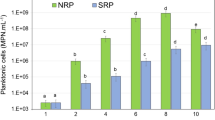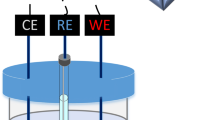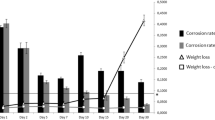Abstract
Representative microbial cultures from an oil reservoir and electrochemical techniques including potentiodynamic scan and linear polarization were used to investigate the time dependent corrosion rate associated with control of biogenic sulphide production through addition of nitrite, nitrate and a combination of nitrate-reducing, sulphide-oxidizing bacteria (NR-SOB) and nitrate. The addition of nitrate alone did not prevent the biogenic production of sulphide but the produced sulphide was eventually oxidized and removed from the system. The addition of nitrate and NR-SOB had a similar effect on oxidation and removal of sulphide present in the system. However, as the addition of nitrate and NR-SOB was performed towards the end of sulphide production phase, the assessment of immediate impact was not possible. The addition of nitrite inhibited the biogenic production of sulphide immediately and led to removal of sulphide through nitrite mediated chemical oxidation of sulphide. The real time corrosion rate measurement revealed that in all three cases an acceleration in the corrosion rate occurred during the oxidation and removal of sulphide. Amendments of nitrate and NR-SOB or nitrate alone both gave rise to localized corrosion in the form of pits, with the maximum observed corrosion rates of 0.72 and 1.4 mm year−1, respectively. The addition of nitrite also accelerated the corrosion rate but the maximum corrosion rate observed following nitrite addition was 0.3 mm year−1. Furthermore, in the presence of nitrite the extent of pitting was not as high as those observed with other control methods.






Similar content being viewed by others
References
Bakke R, Rivedal B, Mehan S (1992) Oil reservoir biofouling control. Biofouling 6:53–60
Beech I (2003) Sulfate-reducing bacteria in biofilms on metallic materials and corrosion. Microbiol Today 30:115–117
Beech IB, Sunner J (2004) Biocorrosion: towards understanding interactions between biofilms and metals. Curr Opin Biotechnol 15:181–186
Bjorndalen N, Mustafiz S, Tango M, Islam MR (2003) A novel technique for prevention of microbial corrosion. Energy Sources 25:945–951
Dalsgaard T, Bak F (1994) Nitrate reduction in a sulfate-reducing bacterium, Desulfovibrio desulfuricans, isolated from rice paddy soil: sulfide inhibition, kinetics, and regulation. Appl Environ Microbiol 60:291–297
Eckford RE, Fedorack PM (2002a) Planktonic nitrate-reducing bacteria and sulfate-reducing bacteria in some western Canadian oil field waters. J Ind Microbiol Biotechnol 29:83–92
Eckford RE, Fedorack PM (2002b) Chemical and microbiological changes in laboratory incubations of nitrate amendment “sour” produced waters from three western Canadian oil fields. J Ind Microbiol Biotechnol 29:243–254
Gardner LR, Stewart PS (2002) Action of glutaraldehyde and nitrite against sulfate-reducing bacterial biofilms. J Ind Microbiol Biotechnol 29:354–360
Gevertz D, Telang AJ, Voordouw G, Jenneman GE (2000) Isolation and characterization of strains CVO and FWKO B, two novel nitrate-reducing, sulfide oxidizing bacteria isolated from oil field brine. Appl Environ Microbiol 66:2491–2501
Greene EA, Hubert C, Nemati M, Jenneman GE, Voordouw G (2003) Nitrite reductase activity of sulfate-reducing bacteria prevents their inhibition by nitrate-reducing, sulfide-oxidizing bacteria. Environ Microbiol 5(7):607–617
Hernández Gayosso MJ, Zavala Olivares G, Ruiz Ordaz N, Juárez Ramirez C, Garciá Esquivel R, Padilla Viveros A (2004) Microbial consortium influence upon steel corrosion rate, using polarisation resistance and electrochemical noise techniques. Electrochim Acta 49:4295–4301
Hubert C, Nemati M, Jenneman GE, Voordouw G (2003) Containment of biogenic sulfide production in continuous up-flow packed-bed bioreactors with nitrate or nitrite. Biotechnol Prog 19(2):338–345
Hubert C, Nemati M, Jenneman GE, Voordouw G (2005) Corrosion risk associated with microbial souring control using nitrate or nitrite. Appl Microbiol Biotechnol 68:272–282
Jan-Roblero J, Romero JM, Amaya M, Le Borgne S (2004) Phylogenetic characterization of a corrosive consortium isolated from a sour gas pipeline. Appl Microbiol Biotechnol 64:862–867
Jenneman GE, Moffitt PD, Bala GA, Webb RH (1999) Sulfide removal in reservoir brine by indigenous bacteria. Soc Pet Eng Prod Facil 14:219–225
Kjellerup BV, Veeh RH, Sumithraratne P, Thomsen TR, Buckingham-Meyer K, FrØlund B, Sturman P (2005) Monitoring of microbial souring in chemically treated, produced-water biofilm systems using molecular techniques. J Ind Microbiol Biotechnol 32:163–170
Kodama Y, Watanabe K (2003) Isolation and characterization of a sulfur-oxidizing chemoloithotroph growing on crude oil under anaerobic conditions. Appl Env Microbiol 69(1):107–112
Larsen J (2002) Downhole nitrate applications to control sulphate reducing bacteria activity and reservoir souring. In: Corrosion 2002, proceeding of 57th annual conference, Paper No. 02025
Larsen J, Rod MH, Zwolle S (2004) Prevention of reservoir souring in the Halfdan field by nitrate injection. In: Corrosion 2004, proceeding of 59th annual conference, Paper No. 04762
Magot M, Ollivier B, Patel BKC (2000) Microbiology of petroleum reservoirs. Antonie van Leeuwenhoek 77:103–116
McInerney MJ, Wofford NQ, Sublette KL (1996) Microbial control of hydrogen sulfide production in a porous medium. Appl Biochem Biotechnol 57/58:933–944
Moura I, Bursakov S, Costa C, Moura JJG (1997) Nitrate and nitrite utilization in sulfate-reducing bacteria. Anaerobe 3:279–290
Myhr S, LillebØ BLP, Sunde E, Beeder J, Torsvik T (2002) Inhibition of microbial H2S production in an oil reservoir model column by nitrate injection. Appl Microbiol Biotechnol 58:400–408
Nemati M, Mazutinec T, Jenneman GE, Voordouw G (2001a) Control of biogenic H2S production by nitrite and molybdate. J Ind Microbiol Biotechnol 26:350–355
Nemati M, Jenneman GE, Voordouw G (2001b) Mechanistic study of microbial control of hydrogen sulfide production in oil reservoirs. Biotechnol Bioeng 74(5):424–434
Nemati M, Jenneman GE, Voordouw G (2001c) Impact of nitrate-mediated microbial control of souring in oil reservoirs on the extent of corrosion. Biotechnol Prog 17:852–859
O’Reilly C, Colleran E (2005) Toxicity of nitrite toward mesophilic and thermophilic sulphate-reducing methanogenic and syntrophic populations in anaerobic sludge. J Ind Microbiol Biotechnol 32:46–52
Okabe S, Santegoeds CM, De Beer D (2002) Effect of nitrite and nitrate on in situ sulfide production in an activated sludge immobilized agar gel film as determined by use of microelectrodes. Biotechnol Bioeng 81(5):570–577
Pitonzo BJ, Castro P, Amy PS, Southam G, Jones DA, Ringleberg D (2004) Microbiologically influenced corrosion capability of bacteria isolated from Yucca Mountain. Corrosion 60(1):64–74
Telang AJ, Ebert S, Foght JM, Westlake DWS, Jenneman GE, Gevertz D, Voordouw G (1997) Effect of nitrate injection on the microbial community in an oil field as monitored by reverse sample genome probing. Appl Environ Microbiol 63:1785–1793
Telang AJ, Ebert S, Foght JM, Westlake DWS, Voordouw G (1998) Effects of two diamine biocides on the microbial community from an oil field. Can J Microbiol 44:1060–1065
Thorstenson T, Boedtker G, Sunde E, Beeder J (2002) Biocide replacement by nitrate in seawater injection systems. Corrosion 33:1–10
Valencia-Cantero E, Pena-Cabriales JJ (2003) The corrosion effects of sulfate- and ferric-reducing bacterial consortia on steel. Geomicrobiol J 20:157–169
Van Hamme JD, Singh A, Ward OP (2003) Recent advances in petroleum microbiology. Microbiol Mol Biol Rev 67(4):503–549
Acknowledgments
This work was supported by Discovery Grants from the Natural Sciences and Engineering Research Council of Canada (NSERC) to MN and RWE. Provision of a New Opportunity Fund to MN by Canada Foundation for Innovation is greatly appreciated. The authors would also like to thank Thomas Bonli, Department of Geological Sciences, University of Saskatchewan for the assistance in examination of samples by scanning electron microscope.
Author information
Authors and Affiliations
Corresponding author
Rights and permissions
About this article
Cite this article
Rempel, C.L., Evitts, R.W. & Nemati, M. Dynamics of corrosion rates associated with nitrite or nitrate mediated control of souring under biological conditions simulating an oil reservoir. J IND MICROBIOL BIOTECHNOL 33, 878–886 (2006). https://doi.org/10.1007/s10295-006-0142-z
Received:
Accepted:
Published:
Issue Date:
DOI: https://doi.org/10.1007/s10295-006-0142-z




